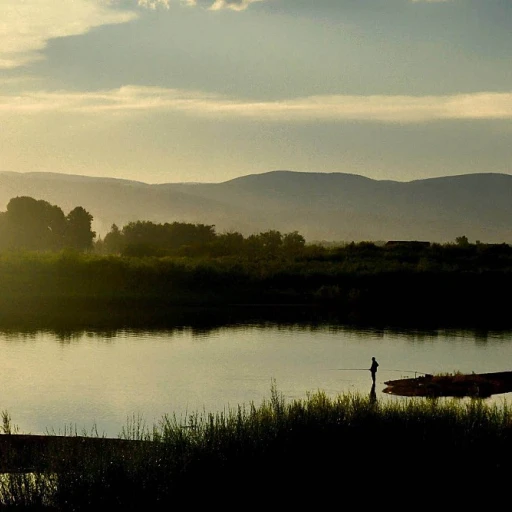The Colorful Spectrum of Fishing Lines
Understanding the Variety of Colors
The vibrant spectrum of fishing lines available today is a testament to the evolving technology and creative innovation in the angling community. These colors aren't just for show; they serve a multitude of purposes that can enhance your fishing experience. Whether you're casting in freshwater streams or saltwater expanses, the color of your fishing line can affect both your approach and success.
Bright fluorescent lines, for instance, are excellent for maintaining visual contact in murky waters or low-light conditions. They make it easier for anglers to detect bites, as the line movement becomes more apparent. On the other hand, camouflage lines, designed to blend seamlessly with underwater surroundings, aim to stay invisible to fish, offering a stealthy option when targeting cautious species.
Clear and translucent lines, similar to the natural hues of the water, are often preferred by anglers when fishing in clear conditions. These choices can help minimize the line's visibility to fish, reducing the chances of spooking them. Understanding these unique qualities is crucial for selecting the right line that matches the natural environment where you plan to fish.
Moreover, some anglers employ colored lines for organizing their fishing gear systematically, distinguishing between setups and methods. The possibilities are endless; every shade and hue brings its own set of advantages to the table.
For more insights on selecting the best braided fishing lines that accommodate both color and performance considerations, don't miss our guide on finding the
ideal braided fishing line for recreational anglers. Embrace the color and explore how it can transform your fishing strategy.
Braided vs. Monofilament: What's the Difference?
Comparing the Characteristics of Braided and Monofilament Lines
When diving into the vast options of fishing line types, it's essential to understand the key differences between braided and monofilament lines. Each type serves its unique purpose and offers distinct benefits tailored for specific fishing needs.
Braided lines are celebrated for their incredible strength and low stretch, making them ideal for deep sea or heavy cover fishing. This thin yet remarkably strong line allows anglers to fit more of it onto the reel, making it a favorite for experienced fishers targeting large species. However, its visibility in clear waters can be a downside, requiring a leader material like monofilament or fluorocarbon.
On the other hand, monofilament lines are made from a single fiber, offering a degree of stretch that can be beneficial in certain fishing situations—such as preventing line breakage during a fish's sudden run. Its ease of handling and knots stays another advantage, often making it the go-to choice for beginners. For those interested in expanding their knot-tying expertise, our detailed guide on mastering the fishing line knot is an excellent resource.
Each type of line carries its pros and cons; understanding these can significantly enhance your fishing experience. Whether you're casting in crystal-clear waters with monofilament or reeling in the hefty game with braided, choosing the right line can make a world of difference in your angling adventure. Stay tuned as we explore how to match these lines to your fishing tackle in the next section.
Choosing the Right Line for Your Tackle
Finding the Perfect Fishing Line for Your Gear
When it comes to outfitting your fishing tackle with the right line, the variety of choices can seem overwhelming. With the vivid range of colors available on the market today, selecting the optimal line for your fishing needs involves a combination of factors, including strength, visibility, and the specific demands of your tackle setup.
One key consideration when choosing a fishing line is ensuring it complements your existing gear. For example, if you opt for a bright-colored line, it becomes easier to track in the water, which can be particularly beneficial when navigating challenging environment conditions or casting across vast expanses. But remember, visibility is only one piece of the puzzle.
Matching the line's specifications with your fishing rod and reel is crucial. Monofilament lines, known for their flexibility and ease of use, might be a great fit for beginners or traditional anglers. In contrast, braided lines offer superior strength and durability, making them ideal for those targeting larger species or fishing in areas with heavy cover (read more about how to tie them to leaders for maximum success
here). Each type has its benefits and drawbacks, as we explored earlier.
Ultimately, the perfect line for your tackle depends on a mix of personal preferences, fishing conditions, and the species you're aiming to catch. While price points and reviews can guide your decision, incorporating personal stories and experiences can bring you closer to finding your ideal setup. Fishing is a personal journey, and your choice of line should reflect your unique angling style.
If musky fishing is on your agenda, you might want to explore
the top musky lures that reel in the big catch to enhance your setup even further.
Price Points and Reviews: Getting the Best Bang for Your Buck
Evaluating Cost-effectiveness and Customer Reviews
When it comes to fishing lines, ensuring you get the best value for your investment is crucial. As fishing enthusiasts know, selecting the right line might be just as important as picking the perfect rod or reel. From monofilament to braided lines, prices can vary widely, influencing your final decision.
A key factor that often affects the price is the material and technology behind the line. For instance, many anglers prefer braided lines for their strength and durability, which may come at a higher price compared to monofilament options. But budget-conscious anglers might find the affordability of monofilament alluring, despite its susceptibility to UV damage over time. For more details on what contributes to these differences, you can explore this
in-depth analysis of fishing line compositions.
Customer reviews are another essential component to consider. Firsthand accounts from fellow anglers can provide insightful information on the performance and reliability of particular brands or colors of fishing lines. While one fisherman might rave about a fluorescent green line's visibility in murky waters, another might express a preference for a more subtle color in clear lakes. We previously discussed how different colored lines could impact fish behavior, helping you make an informed choice.
Comparing options doesn’t solely rely on internet research; visiting sporting goods stores and speaking with local anglers can prove beneficial as well. Hands-on examination and discussions can offer valuable insight into getting the best bang for your buck, ensuring you make a choice that fits both your budget and fishing needs perfectly.
The Impact of Line Color on Fish Reaction
How Line Color Influences Fish Behavior
When selecting fishing lines, one might not immediately consider the importance of color. However, the color of your line can significantly influence how fish perceive and react to it. In our previous discussions, we've outlined the various types and price ranges of fishing lines, but now let's delve into how color can affect fish behavior.
Different colors serve specific purposes based on water conditions and target species. For instance, in clear water or when targeting cautious species, a subtle color like green can blend seamlessly with the surroundings, making your line less visible to fish. On the other hand, a brightly colored line might be more suitable in murky waters or low-light conditions, where visibility to the angler is crucial.
Understanding the visual capabilities of fish is essential when choosing the color of your line. Many species perceive certain colors differently, which can be a crucial factor in either enticing a fish to bite or causing it to shy away. While scientific studies are ongoing to explore this phenomenon further, anecdotal evidence from seasoned anglers suggests that line color can make all the difference in a successful outing.
Ultimately, the choice of line color should be tailored to the specific fishing environment, the species being targeted, and personal preference. As with many aspects of fishing, experience and experimentation play pivotal roles in determining what works best. Aligning your choice of line with the intricacies of fish behavior can enhance your fishing experience, making it as rewarding as it is vibrant. Happy fishing out there!
Personal Stories and Experiences with Colored Lines
A Fisherman's Tale: Experiences with Various Fishing Line Colors
Every angler has a unique story about their journey with different fishing line colors. The choice of color can sometimes make all the difference between a memorable catch and an uneventful day on the water.
Many experienced fishermen swear by the use of vibrant lines, claiming they provide an edge in specific conditions. For instance, a story is often told of an angler who was struggling to attract fish in murky waters. Switching from a traditional clear line to a fluorescent green one, as they recall, was a game-changer. The increased visibility allowed for better line control and significantly improved their catch rate on what could have been a frustrating day.
Conversely, a seasoned angler recounts his experience with a subtle, clear blue line that blended seamlessly with the clear waters of a favorite fishing spot. The line's camouflaging effect kept his presence concealed from the fish, thereby increasing the number of catches without startling the wary prey.
Such tales abound in the fishing community, and they highlight the intricate dance between choosing the perfect line color and understanding the fish's environment and reaction, which aligns with our earlier discussion on the impact of line color on fish reaction.
Different lines not only serve functional purposes but can carry sentimental value as well. A novice fisherman might remember his very first catch on a brightly hued line given by a mentor, making that color a constant choice in their tackle box.
These personal stories and experiences underscore the importance of experimenting with various fishing line colors. Whether it's due to sentimental nostalgia or the strategic advantage a particular hue offers, choosing the right color line can often be as rewarding as landing the catch of a lifetime.

